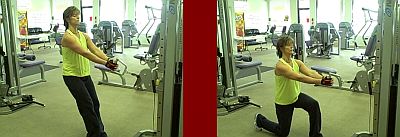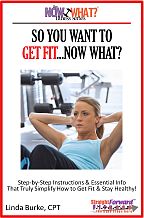|

|
| |
CARBS, PROTEIN, AND FAT
OH MY!!
HOW MANY CALORIES DO YOU NEED DAILY? The amount of calories one should consume daily varies from individual to individual according to gender, size, age, activity level, etc. According to the American Council on Exercise (ACE), normal, healthy adults of average size who engage in physical activity should consume the following amounts of nutrients daily to remain in optimal health:
- Protein—approximately 50 to 70 grams, depending on body size, or about 15% to 20% of total caloric intake.
- Carbohydrates—a minimum of 125 grams, optimal 250 to 400 grams, or 55% to 65% of total caloric intake.
- Fat—approximately 30 to 65 grams, depending on caloric consumption, or 25% to 30% of total caloric intake.
- Vitamins—specific amounts are listed in the Recommended Dietary Allowances (RDA).
- Minerals—specific amounts are listed in the RDA.
- Water—2 to 3 quarts per day.
PROTEIN
Protein’s principle role is to build and repair body tissues such as muscles, ligaments, and tendons. It’s also important for synthesis of hormones, enzymes, and antibodies, as well as for fluid transport and energy. Contrary to popular belief, protein is not a primary source of energy, except when you do not consume enough calories or carbohydrates. If you fail to eat enough, then protein is stripped from the muscle and used as an energy source instead of being used for its intended job of building tissue, enzymes, hormones, etc.
NOTE: The intake of protein supplementation is controversial. However, I feel that it is always best to get your protein through whole food rather than supplementation (protein powder or protein bars) whenever possible.
How much protein do we really need? Available research shows that the average person requires 0.8 grams of protein per kilogram of body weight (2.2 lbs) each day. Generally, the dietary intake of most individuals exceeds even the highest recommendation. For athletic people and those engaged in competitive activities, it is recommended to have 1.2 to 2.0 grams of protein per kilogram of body weight. The increase in protein requirements is mainly a result of increased caloric needs due to the increase in activity level of the athlete. It is generally believed that the protein requirement for resistance athletes falls near the lower end of this range, while endurance athletes need slightly more. Keep in mind that too much protein may cause weight gain, kidney and liver stress, and loss of urinary calcium.
Equation for figuring protein intake: Your weight in lbs._____ ÷ 2.2 = weight in kilograms. Your weight in kilograms _____ x (anywhere from 0.8 to 2.0) = _____ protein requirement per day. Unless you are a competitive athlete, I recommend you stay on the lower end of the scale: 0.8 – 1.2. If you work out strenuously and regularly you may want to consider somewhere between 1 and 2.
PROTEIN SOURCE: Good protein sources are lean meat, egg whites, poultry without skin, fish, skim milk, nonfat cheese, dried beans and peas, nuts, and seeds.
CARBOHYDRATES
Carbs are the most important nutrient for exercising muscles. Not only are adequate amounts of carbs important for muscular performance but for the brain and central nervous system. Carbohydrates serve as primary energy source for working muscles and help the body use fat more efficiently. Stored carbs in the form of glycogen are the primary fuel for exercise. ACE, ACSM (American College of Sports Medicine), and the Food Pyramid Guide recommend that you consume 55% to 65% of your calories from carbs.
So, to be very, very clear: Contrary to popular belief, CARBS ARE GOOD. CARBS ARE OUR FRIENDS. Do not fear the carb! However, it is important to make smart carb choices versus poor carb choices.
CARB SOURCE: Most of your carbs should come from complex carbs such as starches, fruits, vegetables, whole grains and breads, cereals and pasta as opposed to sugary foods and processed foods such as juices, desserts, and sweets.
REALLY COOL TIP: Try to cut back on white carbs like white potatoes (eat sweet potatoes instead), white rice (go brown!), white bread (make it whole grain or whole wheat), etc. In other words, eat whole grain or wheat products and brown carbs instead of white whenever possible.
FAT
Fat is the primary fuel for light to moderate intensity exercise. It is the most concentrated source of food energy and supplies more than twice (9 kcal/gram) as many calories by weight as protein or carbohydrates (4 kcal/gram). You should consume no more than 25% to 30% of your calorie intake from fat.
ANOTHER REALLY COOL TIP: Go to
freedieting.com
for an excellent free calculation of your daily caloric needs. They have a whole slew of other calculators on that page that are fun and interesting to play with, so be sure and check it out.
Learning how many calories you need and what they should consist of ensures that you can better plan your nutrition in order to achieve your fitness goals.
EXERCISE OF THE MONTH
This is the part of the newsletter where I picture an exercise and give explicit instructions on its proper execution.
People are always asking me for butt exercises, so here comes a great one! This has to be my all-time favorite. If you want work those glutes, baby, you got to give this a shot! Try this exercise! It is waaaaay more challenging than it looks. It's actually a quadruple whammy because it also hits your quadriceps, hamstrings, and calves! Can you say, BONUS?!?! This is like a regular lunge, but it is much easier on the knees.
Hanging or Anchored Reverse Lunge
Primary Muscle Group Worked: Quadriceps.
Muscle Groups Worked in this Exercise: Gluteus Maximus (big ole butt), Biceps femoris (hamstrings), Gastrocnemius (calves). Pretty much total lower body.

To see a video of this exercise go to:
Hanging Reverse Lunges
Preparation:1. Fix a handle at about hip to waist height on a cable machine and place pin as heavy as it will go so that it will support your body weight.
2. Straighten your arms and grasp the handle in front of you and stand in a hanging position (almost like you are getting ready to water ski). This will be your starting position.
Execution: 1. Step backward with your right leg around two feet or so from the left foot and lower your upper body down, while keeping the torso upright and maintaining balance. Inhale as you go down. Tip: Do not allow your knee to go forward beyond your toes as you come down, as this will put undue stress on the knee joint. Make sure that you keep your front shin perpendicular to the ground. Keep the torso upright during the lunge; flexible hip flexors are important. A long lunge emphasizes the Gluteus Maximus; a short lunge emphasizes Quadriceps.
2. Push up and go back to the starting position as you exhale. Tip: Use the ball of your feet to push in order to accentuate the quadriceps. To focus on the glutes, press with your heels.
3. Alternate legs for desired reps (preferably 10-12).
HEREIN LIES THE CHALLENGE: Go slow. Do Not Rush This. And whatever you do, don't give up! It definitely takes practice and you may feel a little drunk at first. Hang in there, though! Your butt and lower body will be sore in all the right places tomorrow which should tell you that you are working a major problem area and that just feels dang good!!!
THE PONDER POND
Okay, peeps! This is the inspirational part of the newsletter known as the "Ponder Pond" where you're welcome to take a swim in the sweet waters of inspiration.
In honor of the anniversary of one of the world's saddest and most tragic events, 9/11, I wanted to post this poignant
video.
I found it to be very heart wrenching and thought provoking. Why not send a prayer out to all the people who were so deeply affected by the profound events of that day, which includes everyone on planet earth, whether they understand this or not.
Well, that's about it for this time! I hope you enjoyed this month's newsletter and until the next issue, may the wind be at your back and improved health and vitality your new reality!
If you enjoyed this newsletter, please feel free to pay it forward to anyone you think would like it too. That is the best compliment you could ever pay me, and I appreciate it very, very much.
And don't forget to tell everybody about
Straightforwardfitness.com
where they can get all the free fitness info their heart desires and sign up for this newsletter while they are there.
From my heart to your health,
Linda Burke, CPT
|
|
Buy The Now What? Fitness Series Books Here!

Please go to
Amazon.com
or
Smashwords
to purchase any version your little ole' heart desires.
To Get a Free Copy of The Gym Equipment Handbook
and Much, Much More...Simply Click on the "Click Here" Button Above or Click on My Book Below and Enjoy All the Free Gifts on That Page That You Want!

Sign Up Below For Your Free Monthly Newsletter, The Straightforward Fitness Flash!
|






